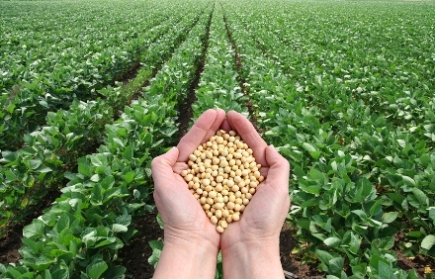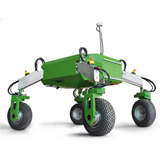Currently generating revenue of $67.3 billion across a host of agricultural categories, the sector is tipped to grow by 5.7 per cent from 2014 to 2019 to reach total revenue of $71.1 billion.
"Australia is very well placed to take advantage of our highly productive soils, efficient farming practices and geographic position on the doorstep of Asia. IBISWorld anticipates that growth in Australian hydroponics, organic farming and recent free trade agreements will see more Australian produce being exported," said Ruthven.
Hydroponics
In the face of anticipated ongoing domestic water shortages and the likelihood of more droughts, IBISWorld expects more time and capital will be invested in hydroponic farming, given the potential for significant water savings and greater efficiencies in growing fruit and vegetables.
"By 2019, hydroponics will likely be generating more than $1.1 billion for the Australian economy, up 23.1 per cent from 2014. The complete control of environmental variables, which largely negate the impact of floods, droughts, adverse weather conditions and natural disasters, will not only reduce labour costs, but also offer greater security in the supply of vegetables, flowers and fruit," Ruthven said.
The anticipated growth in hydroponics is largely attributable to more stable output volumes, a greater focus on quality control and the production of premium products. Due to the perishable nature of hydroponically grown produce, however, trade in the industry is currently low. Advances in refrigeration, enhanced transportation and storage are expected to result in future increases in exports of hydroponically grown food.
Organic farming
Organic farming is blossoming and has been one of the economy's best performing agricultural industries over the past five years. Global demand for organic produce is rising because of increasing health consciousness, growing concern for the environment, steady income growth and the increased convenience of organic food.
"Organic agriculture is forecast to record outstanding growth of 11.2 per cent in 2014 to $655.3 million and 49.6 per cent over the next five years," Ruthven said.
Australia has the largest amount of organic farmland in the world, at an estimated 12 million hectares. The majority of this land is large rangelands used for organic cattle production. However, the industry is mainly comprised of small operators, which has contributed to difficulties in providing consistency in the quantity and quality of produce. Despite some consolidation of operators over the past five years, the industry remains highly fragmented and organic farming techniques are still not as efficient as conventional farming.
Free trade agreements
Australian agricultural exports are worth more than $38.0 billion to the Australian economy annually. As Asia's population continues to grow, IBISWorld anticipates Australian farmers will export more food as the nation cements itself as the breadbasket of the region.
"Beef is expected to be one of the biggest beneficiaries of the recent free trade agreements reached with Japan and Korea, as quotas and tariffs are either significantly reduced or eliminated altogether," Ruthven said.
Currently, $641.0 million of Australian beef and veal and $77.0 million of dairy products are exported to Korea. Australian beef is the largest imported agricultural product in Japan, valued at $1.4 billion in 2013.
Support for agriculture
Excluding drought assistance, Australian farm subsidies are the second lowest in the OECD at just 2.7 per cent of farm revenue, down from 4.8 per cent in 2007. Farm subsidies have been declining in Australia but are expected to remain at the current level over the next five years. Since subsidies are at a low level in Australia they have a small effect on agricultural profitability, but if foreign governments lower their subsidies, Australian farmers will reap the benefits through higher food prices.
"Only our cousins in New Zealand beat us in having lower agricultural subsidies at 0.8 per cent. The European Union, through its Common Agricultural Policy, supports its farmers to the tune of 19.0 per cent, while American farmers receive 7.1 per cent of their income from subsidies, "Ruthven said.
Beef cattle farming
Beef cattle farming is expected to perform well in 2014, with revenue growing 3.3 per cent to $5.5 billion. This healthy growth is expected to continue over the next five years, with revenue forecast to reach $6.3 billion by 2019.
"Demand for Australian beef is expected to remain strong both at home and abroad, despite increased health consciousness favouring white meat and fish," Ruthven said.
Rising meat consumption and higher beef prices are expected to boost domestic demand. Price rises will be driven by the increased popularity of higher value beef products, such as organic and Wagyu beef. The volume of live cattle exports is expected to increase due to growing demand in Asian and Middle Eastern markets and depreciation in the Australian dollar from historically high levels.
Grain growing
Grain producers will celebrate as revenue grows by a forecast 9.5 per cent over the five years through 2019, to more than $14.0 billion.
"The grain producing industry has been affected by high levels of volatility over the past five years, marked by inclement weather conditions that have dampened output. Revenue volatility has been exacerbated by tumultuous global grain prices and global crop supply. More favourable weather conditions and planting conditions are projected to buttress production output and increased revenue will follow," Ruthven said.
- Suppliers
- New to IndustrySearch? Book a Demo
- Advertise with us
- Login
- Email Marketing
- Buyers
- Get Quotes
- Articles & Ideas
- Login
- Subscribe to newsletter
- My Details
- Get Quotes
- Automation & Control
- Automotive Workshop Equipment
- Cleaning Equipment
- Construction & Heavy Machinery
- Conveyor Systems & Components
- Cranes & Hoists
- Electrical & Power Generation Equipment
- Electronic Components
- Farming & Agriculture
- Food & Beverage Processing
- Forklifts & Attachments
- Hydraulic & Pneumatic Equipment
- Industrial Materials, Tools & Components
- Industrial Pumps
- IT Hardware & Industrial Computing
- IT Software & Applications
- Laboratory Equipment & Instruments
- Manufacturing & Industrial Equipment
- Material Handling & Lifting
- Metalworking & Machining
- Mining Equipment & Machinery
- Packaging & Labelling Machinery
- Pallet Management
- Personal Protective Equipment
- Security & Surveillance
- Test & Measurement
- Transport Equipment
- Trucks & Trailers
- Warehouse Storage & Racking
- Waste & Environmental Management
- Welding Machines & Accessories
- Woodworking & Joinery Machines
- Workplace Equipment
- Workplace Safety Equipment
- Get Quotes
- Automation & Control
- Automotive Workshop Equipment
- Cleaning Equipment
- Construction & Heavy Machinery
- Conveyor Systems & Components
- Cranes & Hoists
- Electrical & Power Generation Equipment
- Electronic Components
- Farming & Agriculture
- Food & Beverage Processing
- Forklifts & Attachments
- Hydraulic & Pneumatic Equipment
- Industrial Materials, Tools & Components
- Industrial Pumps
- IT Hardware & Industrial Computing
- IT Software & Applications
- Laboratory Equipment & Instruments
- Manufacturing & Industrial Equipment
- Material Handling & Lifting
- Metalworking & Machining
- Mining Equipment & Machinery
- Packaging & Labelling Machinery
- Pallet Management
- Personal Protective Equipment
- Security & Surveillance
- Test & Measurement
- Transport Equipment
- Trucks & Trailers
- Warehouse Storage & Racking
- Waste & Environmental Management
- Welding Machines & Accessories
- Woodworking & Joinery Machines
- Workplace Equipment
- Workplace Safety Equipment
Trusted by 1.2 million Australian industrial buyers
Buyers
- Discover products & solutions
- Login
- Subscribe To Newsletter
- Browse All Products
- Read Articles
Suppliers
Advertise
- Promote your products & solutions
- New to IndustrySearch? Book a Demo
- Login / Forgot Password
- Advertise Your Products
- Success Stories
- Email Marketing
- Suppliers
- Advertise with us
- Login
- Email Marketing
- Buyers
- Get Quotes
- Articles & Ideas
- Login
- Subscribe to newsletter
- My Details
Get Quotes
- Automation & Control
- Automotive Workshop Equipment
- Cleaning Equipment
- Construction & Heavy Machinery
- Conveyor Systems & Components
- Cranes & Hoists
- Electrical & Power Generation Equipment
- Electronic Components
- Farming & Agriculture
- Food & Beverage Processing
- Forklifts & Attachments
- Hydraulic & Pneumatic Equipment
- Industrial Materials, Tools & Components
- Industrial Pumps
- IT Hardware & Industrial Computing
- IT Software & Applications
- Laboratory Equipment & Instruments
- Manufacturing & Industrial Equipment
- Material Handling & Lifting
- Metalworking & Machining
- Mining Equipment & Machinery
- Packaging & Labelling Machinery
- Pallet Management
- Personal Protective Equipment
- Security & Surveillance
- Test & Measurement
- Transport Equipment
- Trucks & Trailers
- Warehouse Storage & Racking
- Waste & Environmental Management
- Welding Machines & Accessories
- Woodworking & Joinery Machines
- Workplace Equipment
- Workplace Safety Equipment
Get Quotes
- Automation & Control
- Automotive Workshop Equipment
- Cleaning Equipment
- Construction & Heavy Machinery
- Conveyor Systems & Components
- Cranes & Hoists
- Electrical & Power Generation Equipment
- Electronic Components
- Farming & Agriculture
- Food & Beverage Processing
- Forklifts & Attachments
- Hydraulic & Pneumatic Equipment
- Industrial Materials, Tools & Components
- Industrial Pumps
- IT Hardware & Industrial Computing
- IT Software & Applications
- Laboratory Equipment & Instruments
- Manufacturing & Industrial Equipment
- Material Handling & Lifting
- Metalworking & Machining
- Mining Equipment & Machinery
- Packaging & Labelling Machinery
- Pallet Management
- Personal Protective Equipment
- Security & Surveillance
- Test & Measurement
- Transport Equipment
- Trucks & Trailers
- Warehouse Storage & Racking
- Waste & Environmental Management
- Welding Machines & Accessories
- Woodworking & Joinery Machines
- Workplace Equipment
- Workplace Safety Equipment
Trusted by 1.2 million Australian industrial buyers








-160x160-state_article-rel-cat.png)






-160x160-state_article-rel-cat.png)
